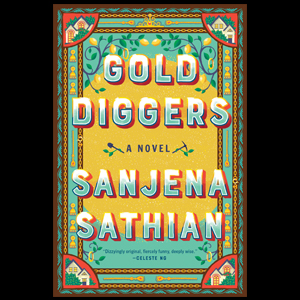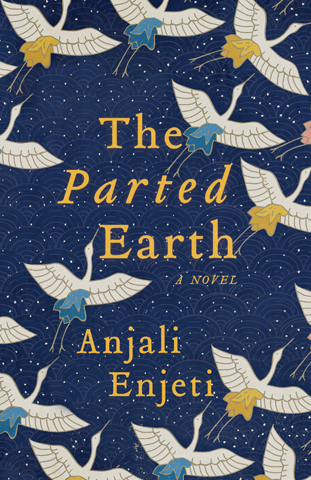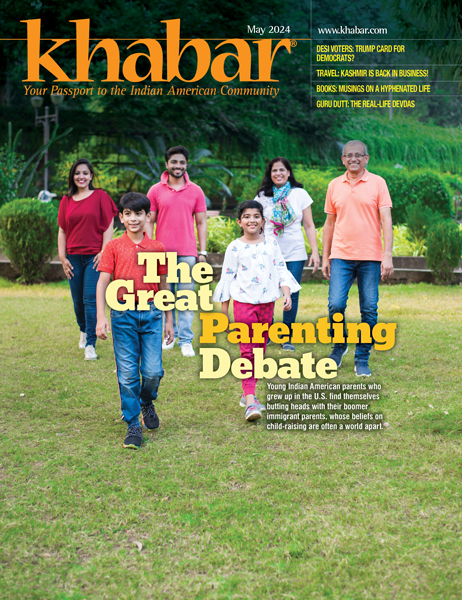Books: Atlantans Explore Desi Lives in America

Two debut novels, by Atlantans Sanjena Sathian and Anjali Enjeti, are set largely in the metro area—and they’re among the most eagerly anticipated fiction titles of the season.
Gold Diggers
By Sanjena Sathian
Penguin Press
Daily Show reporter Ronnie Chieng delivered a neat skit about Andrew Yang’s rise on the national stage in 2019. Think about how inspirational an Asian president would be for Asian kids, he said. “You can tell them, you don’t have to be just a neurosurgeon.” Chieng had his tongue firmly in cheek as he delivered that punchline, but most such pieces are steeped in a few grains of truth.
The high-voltage pressure cauldron that desi kids are immersed in right from the get-go might sound like well-worn ground for a novel, but debut author Sanjena Sathian takes that familiar, practically cliché material, and makes it shine. That key ingredient that’s needed—ambition—is what Neil “Neeraj” Narayan, the protagonist, is missing. And in a community where drive is what will get you places, that lack of spark is a huge problem. Neil coasts along for a while—“When I was younger, I consisted of little but my parents’ ambitions for who I was to become.”— but he is at Okefenokee High School in Hammond Creek (which may remind some readers of Johns Creek), Georgia, when the race truly heats up. Worse, his older sister, Prachi, is pretty much assured of admission to Duke. The Ivy League is where it’s at. While Prachi was leading a “much more documentable high school life,” Neil is happy just to wander around the fringes trying to survive the teen years and a simmering crush on Anita Dayal, his classmate who lives in the same cul-de-sac.
But Neil’s parents are not the ones to give up that easily. They caution against indulging in “nonsense” and insist Neil focus on studies instead. “Ambition: the substance to settle the nerves of immigrant parents. Ambition: the point of that summer, for me, was to acquire some,” Neil recounts. Fortunately for Neil, he chances upon a scheme through which he can lap some up, quite literally. It turns out that Anjali Aunty, Anita’s mom, is an alchemist on the sly. Mother and daughter steal small pieces of gold jewelry from the desi community on the sly and dissolve traces of these pieces into lemonade. As a girl growing up in Mumbai, Anjali has seen the magic work up close: her mother fed a similar concoction to Anjali’s brother, Vivek. The formula worked and Vivek nabbed the coveted admission to the Indian Institute of Technology at Mumbai. Now, Anjali believes that the same formula must work to deliver success—read Harvard—for her daughter, Anita.
However, Neal catches the Dayal women in the act. He is recruited into their scheme and for the price of his silence, Neal too has free access to the lemonade supplies. The key element here is that the stolen gold is imbued with the wearer’s ambitions and passes on, through the lemonade, to whoever drinks it. Suddenly Neil is no longer a plodding student. New avenues open up for him. Unfortunately, the overzealous, young and restless Neil does not understand quite where his boundaries lie—a problem that will lead to devastating consequences that haunt much of his adult life.
The novel breaks off from this tragedy and finds both Neil and his sister Prachi, ten years on, in California. Prachi is wrapped up in the Bay Area tech boom and about to get married; while Neil is studying history, trying to finish his thesis on the aftermath of the Gold Rush. Anita is back too and she wants Neil’s help again. More “lemonade” may or may not be on the line.
Sathian exhibits remarkable control over the narrative while giving Neil an unforgettable voice. Along the way, desis will see elements of themselves in the most unexpected places: the pronunciation of 11 as ‘leven, for example. The novel brilliantly reimagines the Indian-American experience as one that is firmly planted in this country’s soil. To Neil, India is mostly theory. It’s a radical departure from the Jhumpa Lahiri style of stories where every narrator feels the tug of the mother country much more decisively. Nevertheless, extraction from the desi experience is not quite possible: “you could never properly avoid, shun, renounce, extract, or untangle yourself from any other desi in Hammond Creek. You were all a part of the same mass. Some days you trampled on one another. Other days, you hid in the same basement, seeking shelter from the same parental storms,” Neil says.
Gold Diggers spins magic out of two parallel plot lines: the Dayal “lemonade” and the desi place in the history of the American Gold Rush. Neil is fascinated by a mysterious historical figure, the Bombayan, and wonders if the Indian-American narrative is more nuanced than he is led to believe. “Sometimes America baffled us teenagers as much as it did our parents. That every emphasis on achieving a certain future came from the anxiety of simply not knowing, none of us knowing, what life here could be. There was no room to imagine multiple sorts of futures. We’d put all our brain power toward conjuring up a single one: Harvard. But. If I had roots in American soil, if we had not all so recently crossed oceans, if our collective past was more textured than I’d been led to believe, then, well, maybe there were other ways of being brown on offer.”
In that sense, Gold Diggers is consumed by an important question: What if there were other ways of being? It’s Neil’s own version of indulging in that all-American obsession—the pursuit of happiness.

The Parted Earth
By Anjali Enjeti
Hub City Press
There’s a reason Amir Karim is drawn to origami: it’s the language of refugees. He first uses the craft to draft secret missives to his friend, Deepa Khanna. Unfortunately, their teen love is quashed by the forces of history as the India-Pakistan partition wrenches them apart. Amir and his family are compelled to move to Lahore and Deepa eventually finds herself in London, moving there when she’s just sixteen.
Anjali Enjeti’s searching and tightly crafted debut novel, The Parted Earth, moves back and forth in time to illuminate the lives of characters who have suffered directly from the fallout of a crucial element in the history of the Indian subcontinent: Partition. We leave Deepa and Amir in 1947, and move to visit with Shan (short for Shanti) in Atlanta in 2016 as she is mourning a miscarriage and the fraying of her marriage to Max. Shan knows there are elements in her family’s narrative that suffer from many loose threads, but she can never quite figure out why they nag at her as they do. Her father, Vijay, had brought her to India once, at a time when she was too young to truly put the pieces of the puzzle together or understand the force that this faraway country exerted on her family.
Looking for a shoulder after her miscarriage, Shan finds a friend in an older woman in Atlanta, Chandani, who is recently widowed, and whose husband, as it turns out, was also deeply scarred by the events of Partition.
In pointillism, small dots of color merge to create an arresting picture. Enjeti aims for a similar effect here. Taken individually, the stories of the characters in the novel are interesting in their own right. There’s Deepa and Amir and Shan, of course, but also a woman in London, Gertrude Enzenebner, who will play a crucial link in the narrative. Piece them all together and you begin to see the missing patterns, the overall story arc as it’s meant to play out. By zeroing in on the elements that form the pith of the novel, The Parted Earth is able to do a lot more with less.
There’s plenty of storytelling, an “epic,” in just over 250 pages. While such economy and precision are advantages most of the time, there are times when one wishes for a little more time with the characters, a chance at more backstory, maybe an occasion to catch our breath. Deepa’s life in London, for example, could have used a little more light, as could her son’s life in Seattle with his white American wife.
One might argue, of course, that all that is extraneous fluff, ripe for the trimming, which The Parted Earth executes so precisely for us. If at times the novel feels like it’s trimmed a little too close to the bone, it nevertheless works in painting a remarkably eloquent picture of the collateral damage of history. Years later, Amir’s sister, Laila will reflect on her brother’s favorite craft as a necessary tool. “Origami signifies the kinds of transformation that refugees must make to start a new life. They must create something new, something beautiful, from a blank page.”
The Parted Earth rips open a raw and festering wound and so the process is expectedly wrenching. Yet, Enjeti’s soulful writing is a healing balm. There’s a lot of pain here but also hope for redemption. It’s proof that even in history’s darkest hours, we can usually spot a light at the end of the tunnel.
Poornima Apte is a Boston-based freelance writer. Find her on Twitter @booksnfreshair
Enjoyed reading Khabar magazine? Subscribe to Khabar and get a full digital copy of this Indian-American community magazine.
blog comments powered by Disqus












